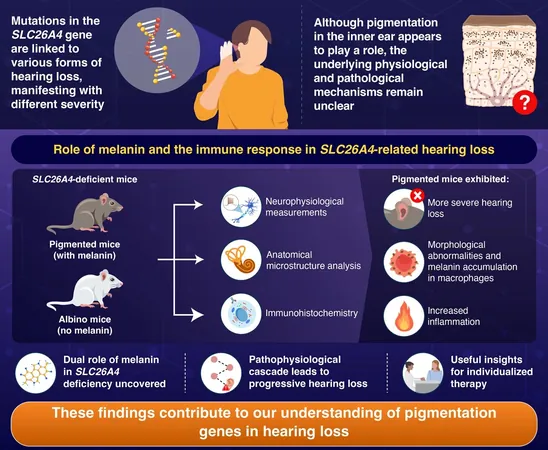
Unraveling the Surprising Connection Between Pigmentation and Hereditary Hearing Loss
2025-07-01
Author: Siti
The Dual Nature of Melanin in Hearing Loss
A groundbreaking study from Japan reveals that melanin can play a dual role in hereditary hearing loss—acting as both a protector and a potential catalyst for worsening the condition. Researchers discovered that disruptions in melanin degradation could lead to its dangerous accumulation in the inner ear, inciting chronic inflammation and activating immune cells. These insights could pave the way for innovative treatments aiming to mitigate certain hereditary hearing loss disorders.
The Mystery of Severe Hearing Loss
Hereditary hearing loss impacts millions globally, yet the reasons behind its varying severity remain largely enigmatic. It's particularly perplexing that patients with the same genetic mutations—even within the same family—experience vastly different symptoms. This stark variability hints at the involvement of additional factors that contribute to disease progression, although pinpointing these factors has proven to be quite challenging.
Melanin's Ambiguous Role in Auditory Health
Recent investigations have unveiled a complex relationship between melanin levels and the inner ear's health. While some studies suggest melanin offers protective antioxidant benefits, others propose that it may fuel inflammatory responses in specific pathological states. The true mechanisms linking melanin to hearing health remain largely elusive.
Inside the Research: Melanin and Hearing Loss in Mice
To demystify this connection, a research team led by Junior Associate Professor Taku Ito from the Institute of Science Tokyo conducted an intriguing study with genetically modified mice lacking the SLC26A4 gene, a mutation commonly associated with hereditary hearing loss in humans. Their findings, published online in *Neurobiology of Disease* on May 17, 2025, revealed that melanin’s influence on hearing loss varies dramatically, depending on the genetic backdrop.
Key Findings of the Study
The researchers examined two groups of SLC26A4-deficient mice—one group without pigmentation and another with normal pigmentation. Utilizing advanced analyses, they discovered that the pigmented mice suffered more severe hearing loss and displayed significantly enlarged macrophages, the immune cells in the inner ear. Rather astonishingly, transcriptomic studies indicated that the accumulation of melanin stemmed not from overproduction, but from breakdown failures.
A Novel Pathological Cascade
The research team proposed an intriguing pathological cascade triggered by the loss of SLC26A4 function, leading to metabolic stress that sabotages melanin degradation. This build-up results in chronic immune cell activation and inflammation, exacerbating hearing loss in pigmented individuals while leaving their non-pigmented counterparts relatively unaffected.
Implications for Future Research and Treatment
The implications of this study are profound for both basic science and clinical applications. Professor Ito emphasizes the context-dependent dual role of melanin, calling attention to its potential as a biomarker for predicting the severity of hereditary hearing loss. As we delve deeper into these findings, the journey towards personalized medicine in treating auditory disorders could become increasingly promising.


 Brasil (PT)
Brasil (PT)
 Canada (EN)
Canada (EN)
 Chile (ES)
Chile (ES)
 Česko (CS)
Česko (CS)
 대한민국 (KO)
대한민국 (KO)
 España (ES)
España (ES)
 France (FR)
France (FR)
 Hong Kong (EN)
Hong Kong (EN)
 Italia (IT)
Italia (IT)
 日本 (JA)
日本 (JA)
 Magyarország (HU)
Magyarország (HU)
 Norge (NO)
Norge (NO)
 Polska (PL)
Polska (PL)
 Schweiz (DE)
Schweiz (DE)
 Singapore (EN)
Singapore (EN)
 Sverige (SV)
Sverige (SV)
 Suomi (FI)
Suomi (FI)
 Türkiye (TR)
Türkiye (TR)
 الإمارات العربية المتحدة (AR)
الإمارات العربية المتحدة (AR)